Related Research Articles
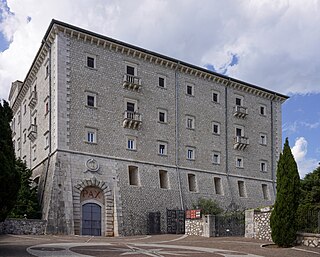
Monte Cassino is a rocky hill about 130 kilometres (80 mi) southeast of Rome, in the Latin Valley, Italy, 2 kilometres west of Cassino and at an elevation of 520 m (1,710 ft). Site of the Roman town of Casinum, it is widely known for its abbey, the first house of the Benedictine Order, having been established by Benedict of Nursia himself around 529. It was for the community of Monte Cassino that the Rule of Saint Benedict was composed.
Pope Gelasius I was the bishop of Rome from 1 March 492 to his death on 19 November 496. Gelasius was a prolific author whose style placed him on the cusp between Late Antiquity and the Early Middle Ages. Some scholars have argued that his predecessor Felix III may have employed him to draft papal documents, although this is not certain.

Samson of Dol was a Welsh saint, who is also counted among the seven founder saints of Brittany with Pol Aurelian, Tugdual or Tudwal, Brieuc, Malo, Patern (Paternus) and Corentin. Born in southern Wales, he died in Dol-de-Bretagne, a small town in north Brittany.
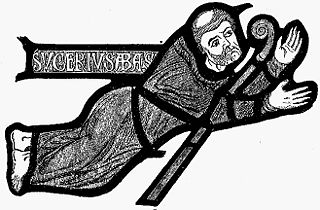
Suger was a French abbot, statesman, and historian. He once lived at the court of Pope Calixtus II in Maguelonne, France. He later became abbot of Saint-Denis, and became a close confidant to King Louis VII, even becoming his regent when the king left for the Second Crusade. Together with the king, he played a part in the centralization in the growing French Kingdom. He authored writings on abbey construction and was one of the earliest patrons of Gothic architecture and is seen as widely credited with popularizing the style.

Moses the Black, also known as Moses the Strong, Moses the Abyssinian, Moses the Robber, and Moses the Ethiopian, was an ascetic monk and priest in Egypt in the fourth century AD, and a Desert Father. He is highly venerated in the Eastern Orthodox Church and the Oriental Orthodox Church. According to stories about him, he converted from a life of crime to one of asceticism. He is mentioned in Sozomen's Ecclesiastical History, written about 70 years after Moses's death.
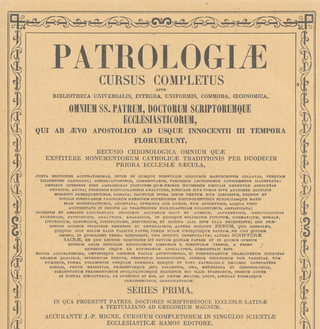
The Patrologia Latina is an enormous collection of the writings of the Church Fathers and other ecclesiastical writers published by Jacques-Paul Migne between 1841 and 1855, with indices published between 1862 and 1865. It is also known as the Latin series as it formed one half of Migne's Patrologiae Cursus Completus, the other part being the Patrologia Graeca of patristic and medieval Greek works with their medieval Latin translations.

The Desert Fathers or Desert Monks were early Christian hermits and ascetics, who lived primarily in the Scetes desert of the Roman province of Egypt, beginning around the third century AD. The Apophthegmata Patrum is a collection of the wisdom of some of the early desert monks and nuns, in print as Sayings of the Desert Fathers. The first Desert Father was Paul of Thebes, and the most well known was Anthony the Great, who moved to the desert in AD 270–271 and became known as both the father and founder of desert monasticism. By the time Anthony had died in AD 356, thousands of monks and nuns had been drawn to living in the desert following Anthony's example, leading his biographer, Athanasius of Alexandria, to write that "the desert had become a city." The Desert Fathers had a major influence on the development of Christianity.
Ammonius is a masculine given name which may refer to:
Gelasius is a masculine given name, from Greek Γελάσιος (Gelásios), from Ancient Greek γέλασις. It may refer to:

January 13 - Eastern Orthodox liturgical calendar - January 15

November 20 - Eastern Orthodox liturgical calendar - November 22

The Monastery of Saint Macarius The Great also known as Dayr Aba Maqār is a Coptic Orthodox monastery located in Wadi El Natrun, Beheira Governorate, about 92 km (57 mi) north-west of Cairo, and off the highway between Cairo and Alexandria.

The Paromeos Monastery, also known as Baramos Monastery, is a Coptic Orthodox monastery located in Wadi El Natrun in the Nitrian Desert, Beheira Governorate, Egypt. It is the most northern among the four current monasteries of Scetis, situated around 9 km northeast of the Monastery of Saint Pishoy. Ecclesiastically, the monastery is dedicated to and named after the Virgin Mary.

Olegarius Bonestruga was the Bishop of Barcelona from 1116 and Archbishop of Tarragona from 1118 until his death. He was an intimate of Ramon Berenguer III, Count of Barcelona, and often accompanied the count on military ventures.

Gerasimus of the Jordan was a Christian saint, monk and abbot of the 5th century AD.
Gerasimus I was the Ecumenical Patriarch of Constantinople from 1320 to 1321.

The Sayings of the Desert Fathers is the name given to various textual collections consisting of stories and sayings attributed to the Desert Fathers and Desert Mothers from approximately the 5th century AD.
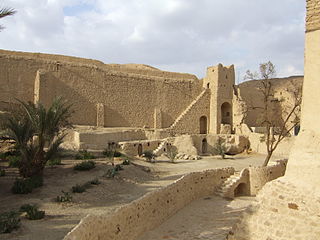
The Monastery of Saint Paul the Anchorite in Egypt is a Coptic Orthodox monastery located in the Eastern Desert, near the Red Sea Mountains. It is about 155 km (96 mi) south east of Cairo. The monastery is also known as the Monastery of the Tigers.
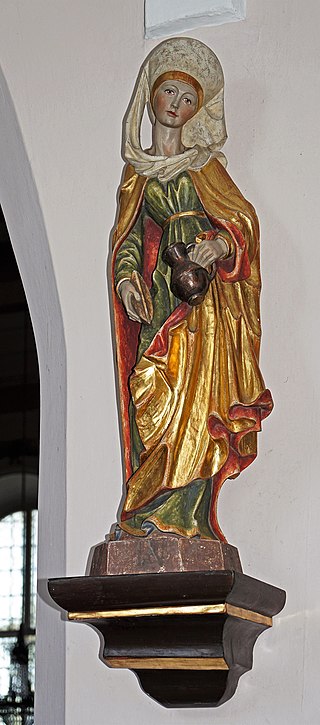
Verena of Zurzach, mostly just called Saint Verena is an early Christian consecrated virgin and hermit. She is especially venerated in Switzerland, where her cult is attested in Bad Zurzach, the reported place of her burial, from at least the 5th century. She is recognized as a saint in the Roman Catholic Church as well as in the Eastern Orthodox Church and the Oriental Orthodox Churches. Her feast is on 1 September.
References
- 1 2 Ward, Benedicta (1984). The sayings of the Desert Fathers: the alphabetical collection. Kalamazoo, MI: Cistercian Publications. ISBN 0-87907-959-2.
- ↑ "Saints-Names-G-1". Tyoos. Retrieved 2021-11-15.